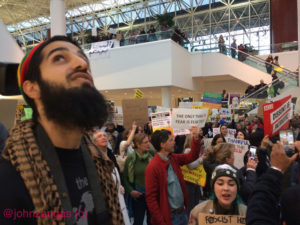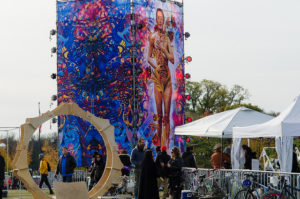2017 was chaotic as independent media faced challenges covering dozens of social justice and environmental stories. Major news events often overlapped, so it was difficult to decide which story to cover.
News media came under attack as the president relentlessly accused publishers of spreading fake news. Independent media faced the ultimate question of whether it could continue reporting because telecoms have now come within a breath of ending the free and open Internet. After years of successful efforts to keep the Internet free, the FCC voted 3-2 to deregulate it, stripping key language from Title II of the Telecommunications Act of 1934, and with that removing Internet protections. News websites like DC Media Group face the possibility that followers will have a harder time accessing our website.
There was the challenge of dealing with burnout as the disheartening nature of the stories we covered began to sink in. Keeping pace with news events was one thing, but seeing the fabric of communities being unraveled by oppressive policies was another.
The past year may be seen as an time of setbacks and defeats for many struggling to come to terms with the fallout, but it was also a time the people to organize and mobilize for common interests.
An Era of New Resistance Rising

Noteworthy in 2017 was the willingness of the people to stand against the new administration and its policies restricting women’s health and rights, curbing immigration, deregulating environmental protections and threatening longstanding freedoms. The administration gave sympathy and comfort to white supremacists. Sensing their new power, Nazis held torch rallies and met in Washington at the Lincoln Memorial on the National Mall and at the White House. But anti-fascist actions were organized to challenge them anyway. Walls of resistance met the neo-Nazis groups wherever they chose to appear.
DC Media Group reporters were there to cover the stories of the anti-racist and anti-fascist pushback from very first hours at the inauguration protests in Washington, DC counter-protests and in Charlottesville in August.
The Inauguration Day protests saw 230 arrests as police swept them up by kettling, a tactic which led to millions in settlements in a lawsuit in 2003. Thousands more protesters blockaded most entry points to the inauguration parade route and were at least partly responsible for reducing attendance.

![]() The very next day the mainstream reacted to Trump’s election, when the Woman’s March on Washington unexpectedly drew close to a million women to Washington, DC. Wearing pink “pussy hats,” which many had knitted themselves from a pattern shared online, and carrying thousands of hand made signs protesting the new president, their chants were a marker of the year of resistance to come.
The very next day the mainstream reacted to Trump’s election, when the Woman’s March on Washington unexpectedly drew close to a million women to Washington, DC. Wearing pink “pussy hats,” which many had knitted themselves from a pattern shared online, and carrying thousands of hand made signs protesting the new president, their chants were a marker of the year of resistance to come.
A group of activists from Popular Resistance shut down entrances to the DNC HQ building in a symbolic attempt to foreclose on and move the DNC office out of town. The video and story from that protest was widely shared as it tapped into overall dissatisfaction with how the DNC handled the campaign during the 2016 presidential election. Popular Resistance also organized a shutdown of I-295 with a giant “Stop Trumpism” sign.
Mainstream Joins Environmental Fights

There was growing concern in academia as the Trump Administration thumbed its nose at science by appointing climate deniers to key cabinet positions, withdrawing from the Paris Climate Accords, and deleting troves of key scientific data from government web sites. This alarmed mainstream scientists which are typically apolitical and avoid public demonstrations. We documented the historic back-to-back March For Science and Climate March which protested Administration policies downplaying the role scientists in proving the earth is imperiled by climate change.
There were a dozen pipeline fights, including Dakota Access Pipeline (DAPL) fight at Standing Rock, the Keystone XL (KXL) battle, the Potomac Pipeline fights and more. The ensuing massive mobilizations by indigenous people played a key role against them in Washington DC, through the court challenges, protests on the Mall, at the White House and in front of the Army Corps of Engineers.
The November ruling by Nebraska Public Service Commission against TransCanada over its preferred route of the KXL pipeline, demonstrated grassroots organizing, coupled with cooperation between allied groups, and persistent engagement with the community, can and does result in wins.
Residents of Lusby, Maryland refused to give up in their fight against a Dominion Energy LNG export terminal being built in their community. They took their fight to Annapolis for 37 weeks of vigils at the Governor’s mansion.
Immigrants Advocate for Their Rights

Immigrants came out of hiding to assert their rights with a new boldness. As the Trump administration launched attacks on immigrant rights, DACA, instituted a Muslim ban from 7 countries and discarded long-standing policies on immigration, we visited airports in Baltimore and Washington, DC to document the resistance to Trump’s executive orders on immigration. “Immigrants Welcome Here” was a common sign at those events. Area businesses closed in support of their immigrant workers, an event we also covered.
The People Said No to Racism and Fascism
In August, when extremist right-wing hate groups descended on Charlottesville we recorded their assaults on citizens who were standing up for equal rights and freedom.

The people said “no” to Civil War era statues which continued to stand as vestiges of supremacy and all around the country, localities were forced to take them down.
We covered the acquittals in the first trial of the Inauguration protests and will cover future trials.
Women Persist in Fight for Equality
In late September, we covered the follow-up to the Women’s March as Black Women led the March For Racial Justice for equal rights and protection from police and community violence. They spoke out against racist statements from within the Administration and accompanying bigoted policies against Muslims, Hispanics, and POC.
Internet Commons Under Threat

We followed activists to the neighborhood of Federal Communications Commission chair Ajit Pai for a leaflet action during the fight to keep the Internet free and open and recorded their vigils outside the FCC during protests against the expected vote against a free and open Internet. We will continue to report the fight for Internet Freedom as the coming court challenges to the vote unfold.
Art as a Tactic of Resistance
We reported from the Catharsis On The Mall event on how artists, doctors, and professionals can use their creativity, knowledge, and talents, to enhance, heal, and build connected communities using their own resources.

And when a local anthropologist organized the “Protest Matters” museum to highlight how local communities can resist oppression and help benefit through mutual aid and cooperation, we reported that as well. It was a demonstration of the capability of communities to fix what needs attention with their own resources.
The Year to Come
2017 showed that the coming year will be far from quiet and more challenging to report. An all-out assault on a free and open Internet after the FCC vote is likely to reduce independent media access to audiences as telecoms curb information access and bite into small web site bandwidth. This will continue to play out in the courts and Congress. But Internet watch groups are readying new fights, and we’ll be there to cover it.
We will also report on the court cases involving the inauguration arrests and keep following the pipeline fights and the Cove Point LNG export terminal.
As the administration continues rolling out its agenda of denying climate science, deregulating environmental protections, rejecting Dreamer’s and immigrant rights, oppressing women, ending Internet Freedoms, assaulting health and education programs designed to help communities and giving space to nationalism and fringe right-wing hate groups, we will continue to bring the stories into focus from the viewpoint of those affected.






